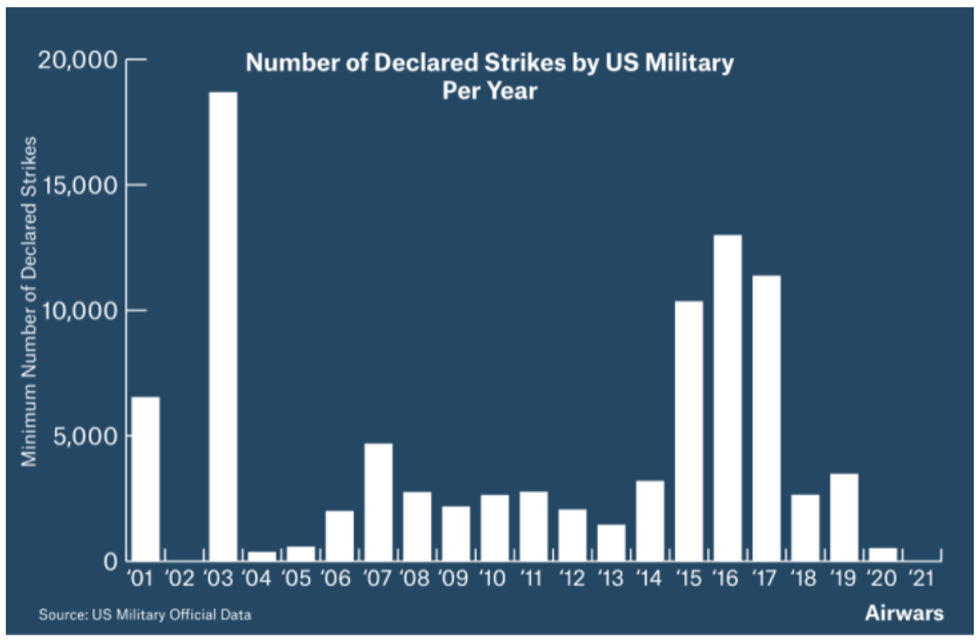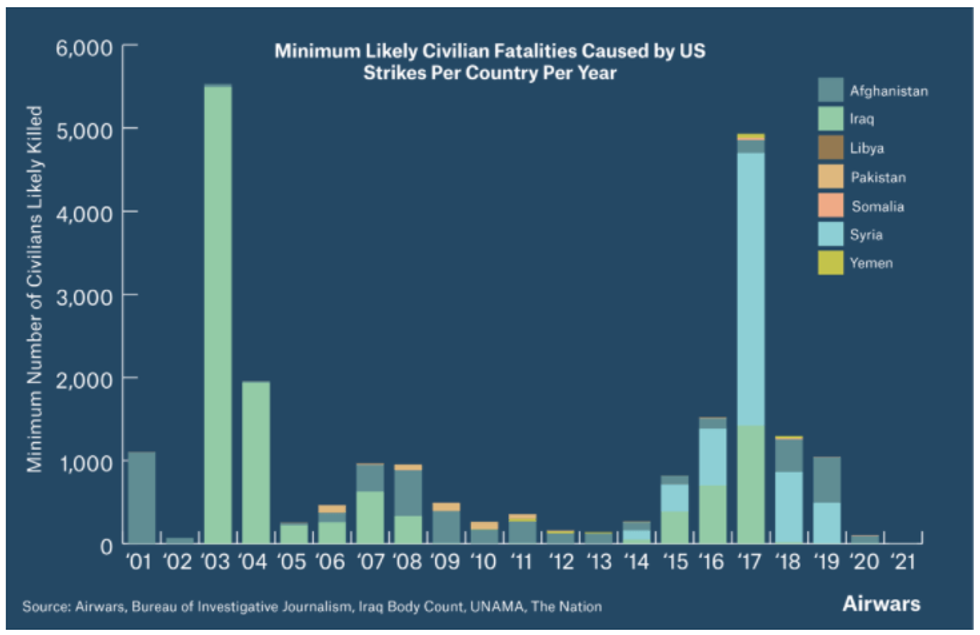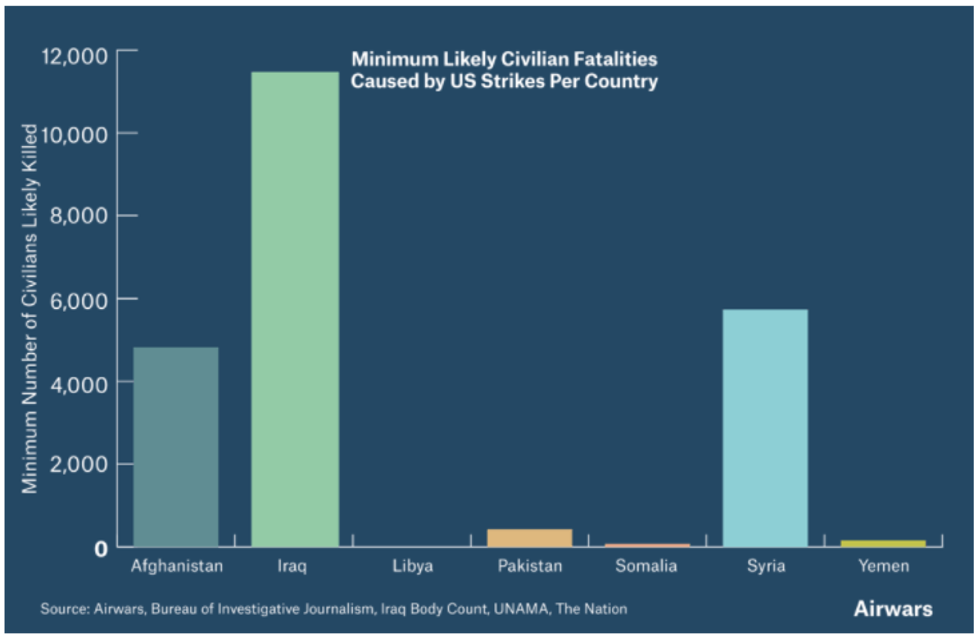
Relatives and neighbors of the Ahmadi family gathered around the incinerated husk of a vehicle hit by a U.S. drone strike in Kabul, Afghanistan on August 30, 2021. (Photo: Marcus Yam/Los Angeles Times via Getty Images)
US Airstrikes Have Killed Up to 48,000 Civilians Since 9/11: Analysis
"On average, U.S.-led airstrikes have killed more than 1,000 civilians a year since 2001."
Airstrikes conducted by the United States have killed between 22,000 and 48,000 civilians since September 11, 2001, according to a report published Monday by Airwars, a military watchdog that monitors and seeks to reduce civilian harm in violent conflict zones.
The new analysis, released ahead of the 20th anniversary of the 9/11 terrorist attacks and the retaliatory launch of the so-called "War on Terror," came just days after a U.S. drone strike killed at least 10 members of a single family in Kabul amid the withdrawal of troops from Afghanistan.
Most media accounts point out that more than 7,000 U.S. service members have died in post-9/11 wars, but only some go on to state the massive civilian death toll, and "almost exclusively in generalities," researchers lamented.
While Brown University's Costs of War project estimates that over 387,000 civilians have been killed as a result of the War on Terror, Airwars sought to answer a specific question: How many civilians have likely been killed by U.S. airstrikes in the last 20 years?
The answer, Airwars found, is least 22,679, and potentially as many 48,308 civilians.
\u201cOn average US-led airstrikes have killed more than 1,000 civilians a year since 2001\u201d— Airwars (@Airwars) 1630965960
Acknowledging the imprecision of their estimate, the group noted that "the gap between these two figures reflects the many unknowns when it comes to civilian harm in war."
"Belligerents rarely track the effects of their own actions--and even then do so poorly," researchers wrote. "It is left to local communities, civil society, and international agencies to count the costs."
The Pentagon has declared a minimum of 91,340 airstrikes in Afghanistan, Iraq, Libya, Pakistan, Somalia, Syria, and Yemen--seven countries the U.S. military invaded or assaulted with bombs or drones--in the past 20 years. Notable peaks occurred during the 2003 invasion of Iraq and between 2015 and 2017, the height of the military offensive against ISIS in Iraq, Syria, and Libya.

Given the dubious nature of data supplied by the U.S. military--which notoriously undercounts civilian fatalities--Airwars "gathered together every reliable assessment of direct civilian harm caused by U.S. actions" to construct a dataset that includes information from the Bureau of Investigative Journalism, Iraq Body Count, The Nation, the United Nations Assistance Mission in Afghanistan, and their own previous studies.
"Wherever possible we sought to measure civilian harm just from U.S. airstrikes but in some cases, such as the first years of the Iraq invasion, it was impossible to disaggregate airstrikes from artillery fire and other heavy munitions, which were therefore included," researchers noted. "Likewise in some U.S.-led coalitions it was impossible to determine whether each individual strike was American, though U.S. airpower has dominated all such campaigns."
Based on its comprehensive review of credible sources, Airwars identified 2003 as the deadliest year of the War on Terror, "when a minimum of 5,529 civilians were reported to have been killed by U.S. actions."
"The next deadliest year was 2017, when at least 4,931 civilians were likely killed, the vast majority in alleged coalition bombing of Iraq and Syria," researchers wrote. "However, if we include maximum estimates of civilian harm then 2017 was in fact the worst year for civilian casualties, with up to 19,623 killed."

According to Airwars, 97% of reported civilian deaths during the War on Terror took place in three countries--Iraq, Afghanistan, and Syria.

Joe Dyke, senior investigator at Airwars, told Middle East Eye that "for much of the last 20 years people living in Washington or New York could have been forgiven for forgetting their country was at war."
"Whether a drone strike in a Yemeni village or a military base in rural Afghanistan, it often felt far removed--almost another world--but that isn't how it felt for those millions of people living in those conflicts," Dyke added.
Meanwhile, in an email responding to Airwars' request for official military estimates of civilian causualties in post-9/11 U.S. wars, the Pentagon said that "the information you request is not immediately on hand in our office as it spans between multiple operations/campaigns within a span of between 18 and 20 years."
An Urgent Message From Our Co-Founder
Dear Common Dreams reader, The U.S. is on a fast track to authoritarianism like nothing I've ever seen. Meanwhile, corporate news outlets are utterly capitulating to Trump, twisting their coverage to avoid drawing his ire while lining up to stuff cash in his pockets. That's why I believe that Common Dreams is doing the best and most consequential reporting that we've ever done. Our small but mighty team is a progressive reporting powerhouse, covering the news every day that the corporate media never will. Our mission has always been simple: To inform. To inspire. And to ignite change for the common good. Now here's the key piece that I want all our readers to understand: None of this would be possible without your financial support. That's not just some fundraising cliche. It's the absolute and literal truth. We don't accept corporate advertising and never will. We don't have a paywall because we don't think people should be blocked from critical news based on their ability to pay. Everything we do is funded by the donations of readers like you. Will you donate now to help power the nonprofit, independent reporting of Common Dreams? Thank you for being a vital member of our community. Together, we can keep independent journalism alive when it’s needed most. - Craig Brown, Co-founder |
Airstrikes conducted by the United States have killed between 22,000 and 48,000 civilians since September 11, 2001, according to a report published Monday by Airwars, a military watchdog that monitors and seeks to reduce civilian harm in violent conflict zones.
The new analysis, released ahead of the 20th anniversary of the 9/11 terrorist attacks and the retaliatory launch of the so-called "War on Terror," came just days after a U.S. drone strike killed at least 10 members of a single family in Kabul amid the withdrawal of troops from Afghanistan.
Most media accounts point out that more than 7,000 U.S. service members have died in post-9/11 wars, but only some go on to state the massive civilian death toll, and "almost exclusively in generalities," researchers lamented.
While Brown University's Costs of War project estimates that over 387,000 civilians have been killed as a result of the War on Terror, Airwars sought to answer a specific question: How many civilians have likely been killed by U.S. airstrikes in the last 20 years?
The answer, Airwars found, is least 22,679, and potentially as many 48,308 civilians.
\u201cOn average US-led airstrikes have killed more than 1,000 civilians a year since 2001\u201d— Airwars (@Airwars) 1630965960
Acknowledging the imprecision of their estimate, the group noted that "the gap between these two figures reflects the many unknowns when it comes to civilian harm in war."
"Belligerents rarely track the effects of their own actions--and even then do so poorly," researchers wrote. "It is left to local communities, civil society, and international agencies to count the costs."
The Pentagon has declared a minimum of 91,340 airstrikes in Afghanistan, Iraq, Libya, Pakistan, Somalia, Syria, and Yemen--seven countries the U.S. military invaded or assaulted with bombs or drones--in the past 20 years. Notable peaks occurred during the 2003 invasion of Iraq and between 2015 and 2017, the height of the military offensive against ISIS in Iraq, Syria, and Libya.

Given the dubious nature of data supplied by the U.S. military--which notoriously undercounts civilian fatalities--Airwars "gathered together every reliable assessment of direct civilian harm caused by U.S. actions" to construct a dataset that includes information from the Bureau of Investigative Journalism, Iraq Body Count, The Nation, the United Nations Assistance Mission in Afghanistan, and their own previous studies.
"Wherever possible we sought to measure civilian harm just from U.S. airstrikes but in some cases, such as the first years of the Iraq invasion, it was impossible to disaggregate airstrikes from artillery fire and other heavy munitions, which were therefore included," researchers noted. "Likewise in some U.S.-led coalitions it was impossible to determine whether each individual strike was American, though U.S. airpower has dominated all such campaigns."
Based on its comprehensive review of credible sources, Airwars identified 2003 as the deadliest year of the War on Terror, "when a minimum of 5,529 civilians were reported to have been killed by U.S. actions."
"The next deadliest year was 2017, when at least 4,931 civilians were likely killed, the vast majority in alleged coalition bombing of Iraq and Syria," researchers wrote. "However, if we include maximum estimates of civilian harm then 2017 was in fact the worst year for civilian casualties, with up to 19,623 killed."

According to Airwars, 97% of reported civilian deaths during the War on Terror took place in three countries--Iraq, Afghanistan, and Syria.

Joe Dyke, senior investigator at Airwars, told Middle East Eye that "for much of the last 20 years people living in Washington or New York could have been forgiven for forgetting their country was at war."
"Whether a drone strike in a Yemeni village or a military base in rural Afghanistan, it often felt far removed--almost another world--but that isn't how it felt for those millions of people living in those conflicts," Dyke added.
Meanwhile, in an email responding to Airwars' request for official military estimates of civilian causualties in post-9/11 U.S. wars, the Pentagon said that "the information you request is not immediately on hand in our office as it spans between multiple operations/campaigns within a span of between 18 and 20 years."
- 'Death Outlives War': Analysis Estimates Post-9/11 Death Toll Tops 4.5 Million ›
- Secret Doc Exposes Flaws in Pentagon Claim That No Civilians Were Killed in al-Baghdadi Raid ›
- Groups Demand US 'Make Long-Overdue Amends' for Airstrikes in Somalia ›
- US Accused of Killing Cuban Doctors in Somalia Airstrike ›
- Families Demand Justice After US Admits Drone Strike Killed Somali Civilians | Common Dreams ›
Airstrikes conducted by the United States have killed between 22,000 and 48,000 civilians since September 11, 2001, according to a report published Monday by Airwars, a military watchdog that monitors and seeks to reduce civilian harm in violent conflict zones.
The new analysis, released ahead of the 20th anniversary of the 9/11 terrorist attacks and the retaliatory launch of the so-called "War on Terror," came just days after a U.S. drone strike killed at least 10 members of a single family in Kabul amid the withdrawal of troops from Afghanistan.
Most media accounts point out that more than 7,000 U.S. service members have died in post-9/11 wars, but only some go on to state the massive civilian death toll, and "almost exclusively in generalities," researchers lamented.
While Brown University's Costs of War project estimates that over 387,000 civilians have been killed as a result of the War on Terror, Airwars sought to answer a specific question: How many civilians have likely been killed by U.S. airstrikes in the last 20 years?
The answer, Airwars found, is least 22,679, and potentially as many 48,308 civilians.
\u201cOn average US-led airstrikes have killed more than 1,000 civilians a year since 2001\u201d— Airwars (@Airwars) 1630965960
Acknowledging the imprecision of their estimate, the group noted that "the gap between these two figures reflects the many unknowns when it comes to civilian harm in war."
"Belligerents rarely track the effects of their own actions--and even then do so poorly," researchers wrote. "It is left to local communities, civil society, and international agencies to count the costs."
The Pentagon has declared a minimum of 91,340 airstrikes in Afghanistan, Iraq, Libya, Pakistan, Somalia, Syria, and Yemen--seven countries the U.S. military invaded or assaulted with bombs or drones--in the past 20 years. Notable peaks occurred during the 2003 invasion of Iraq and between 2015 and 2017, the height of the military offensive against ISIS in Iraq, Syria, and Libya.

Given the dubious nature of data supplied by the U.S. military--which notoriously undercounts civilian fatalities--Airwars "gathered together every reliable assessment of direct civilian harm caused by U.S. actions" to construct a dataset that includes information from the Bureau of Investigative Journalism, Iraq Body Count, The Nation, the United Nations Assistance Mission in Afghanistan, and their own previous studies.
"Wherever possible we sought to measure civilian harm just from U.S. airstrikes but in some cases, such as the first years of the Iraq invasion, it was impossible to disaggregate airstrikes from artillery fire and other heavy munitions, which were therefore included," researchers noted. "Likewise in some U.S.-led coalitions it was impossible to determine whether each individual strike was American, though U.S. airpower has dominated all such campaigns."
Based on its comprehensive review of credible sources, Airwars identified 2003 as the deadliest year of the War on Terror, "when a minimum of 5,529 civilians were reported to have been killed by U.S. actions."
"The next deadliest year was 2017, when at least 4,931 civilians were likely killed, the vast majority in alleged coalition bombing of Iraq and Syria," researchers wrote. "However, if we include maximum estimates of civilian harm then 2017 was in fact the worst year for civilian casualties, with up to 19,623 killed."

According to Airwars, 97% of reported civilian deaths during the War on Terror took place in three countries--Iraq, Afghanistan, and Syria.

Joe Dyke, senior investigator at Airwars, told Middle East Eye that "for much of the last 20 years people living in Washington or New York could have been forgiven for forgetting their country was at war."
"Whether a drone strike in a Yemeni village or a military base in rural Afghanistan, it often felt far removed--almost another world--but that isn't how it felt for those millions of people living in those conflicts," Dyke added.
Meanwhile, in an email responding to Airwars' request for official military estimates of civilian causualties in post-9/11 U.S. wars, the Pentagon said that "the information you request is not immediately on hand in our office as it spans between multiple operations/campaigns within a span of between 18 and 20 years."
- 'Death Outlives War': Analysis Estimates Post-9/11 Death Toll Tops 4.5 Million ›
- Secret Doc Exposes Flaws in Pentagon Claim That No Civilians Were Killed in al-Baghdadi Raid ›
- Groups Demand US 'Make Long-Overdue Amends' for Airstrikes in Somalia ›
- US Accused of Killing Cuban Doctors in Somalia Airstrike ›
- Families Demand Justice After US Admits Drone Strike Killed Somali Civilians | Common Dreams ›

